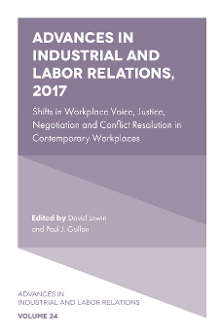
Index
ISBN: 978-1-78743-486-8, eISBN: 978-1-78743-485-1
ISSN: 0742-6186
Publication date: 2 February 2018
Citation
(2018), "Index", Lewin, D. and Gollan, P.J. (Ed.) Advances in Industrial and Labor Relations, 2017: Shifts in Workplace Voice, Justice, Negotiation and Conflict Resolution in Contemporary Workplaces (Advances in Industrial & Labor Relations, Vol. 24), Emerald Publishing Limited, Leeds, pp. 243-251. https://doi.org/10.1108/S0742-618620180000024012
Publisher
:Emerald Publishing Limited
Copyright © 2018 Emerald Publishing Limited
INDEX
Index
- Prelims
- Introduction
- The Social Construction of Workarounds
- Workplace Dispute Resolution: What Guidance Does Existing Research Provide?
- Great in Theory but Tough in Practice: Insights on Sustaining Advanced Employee Involvement at Delta Air Lines
- Voice as an Empowerment Practice: The Case of an Australian Manufacturing Company
- Democracy, Militancy, and Union Revitalization, The DeMReV Model of Union Renewal: A Sustainable, Strategic Model Expanding on Voss and Sherman Model
- Adapting Union Administrative Practices to New Realities: Results of a Twenty-Year Longitudinal Study
- Pro-Social and Self-Interest Motivations for Unionism and Implications for Unions as Institutions
- Can HPWS and Unions Work Together to Reduce Employee Turnover Intention in Foreign MNCs in China?
- Index